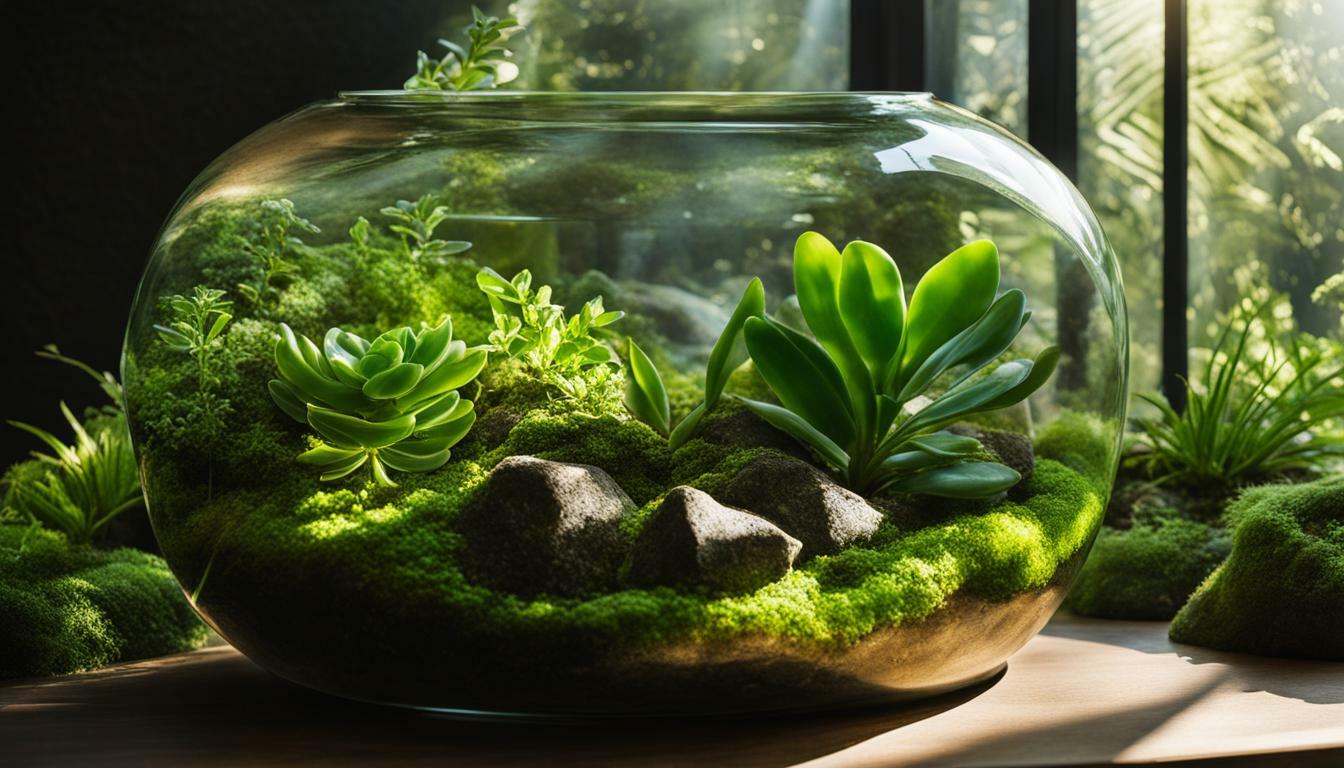Terrarium plants, specifically jade plants, are popular succulent houseplants that can thrive with the right care. These plants are known for their thick, woody stems and oval-shaped leaves, making them a beautiful addition to any indoor garden. Whether you’re a seasoned indoor gardener or just starting out, jade plants are a great choice for your terrarium. In this guide, we will explore everything you need to know about caring for jade plants in a terrarium setting.
Key Takeaways:
- Jade plants are succulent houseplants that can live a long time with proper care.
- They have thick, woody stems and oval-shaped leaves.
- Jade plants can reach heights of three feet or more when grown indoors.
- They adapt well to most homes’ warm, dry conditions.
- Proper watering, lighting, and temperature conditions are essential for their well-being.
Understanding Jade Plants: A Succulent Beauty
Jade plants, known for their thick, woody stems and oval-shaped leaves, are excellent choices for terrariums due to their adaptability and longevity. These popular succulent houseplants can thrive with proper care, making them a favorite among indoor gardeners. With their unique appearance and ability to store water in their fleshy leaves, jade plants are not just visually appealing but also easy to maintain.
When it comes to caring for jade plants in terrariums, there are a few key factors to keep in mind. First and foremost, proper watering is crucial. While jade plants can tolerate dry conditions, they still require regular watering during the growing season. It’s important to allow the soil to dry out between waterings to avoid overwatering, which can lead to root rot. On the other hand, underwatering can cause the leaves to shrivel, so finding the right balance is key.
Jade plants also have specific light requirements. They thrive in bright, indirect light and should ideally receive at least 6 hours of sunlight each day. Placing your terrarium near a window or using artificial grow lights can help provide the necessary light for optimal growth. Additionally, jade plants prefer room temperature but can tolerate slightly cooler temperatures at night and in the winter.
When it comes to fertilizing and repotting, jade plants have modest needs. Fertilizing should be done sparingly using a diluted houseplant or cacti/succulent fertilizer. Repotting is only necessary every 2-3 years for young plants and every 4-5 years for older ones, as they prefer to be slightly pot-bound. Proper care and maintenance will ensure that your jade plant thrives and remains a beautiful addition to your terrarium.
| Key Care Tips for Jade Plants in Terrariums: |
|---|
| Water regularly, allowing the soil to dry out between waterings |
| Place in bright, indirect light with at least 6 hours of sunlight daily |
| Maintain room temperature, with slightly cooler temperatures at night |
| Fertilize sparingly with a diluted houseplant or cacti/succulent fertilizer |
| Repot every 2-3 years for young plants and 4-5 years for older ones |
“Jade plants are not just visually appealing but also easy to maintain.”
Like any other houseplant, jade plants can face common pests and issues. Mealybugs and scale are two pests that can affect jade plants, and it’s important to regularly inspect your plants for signs of infestation. If caught early, these pests can be treated with insecticidal soap or by manually removing them. Additionally, jade plants can be toxic to pets, so it’s important to keep them out of reach of furry friends.
Lastly, while jade plants can be grown outdoors in mild, dry climates, they are susceptible to cold damage. If you choose to keep your terrarium outdoors, ensure that it is in a sheltered location where it is protected from freezing temperatures and excessive moisture.
In conclusion, jade plants are versatile and resilient plants that thrive in terrariums. With their unique appearance and low-maintenance needs, they are a fantastic choice for indoor gardeners looking to create a thriving mini ecosystem. By providing proper care in terms of watering, lighting, temperature, and pest prevention, you can enjoy the beauty of jade plants in your terrarium for years to come.
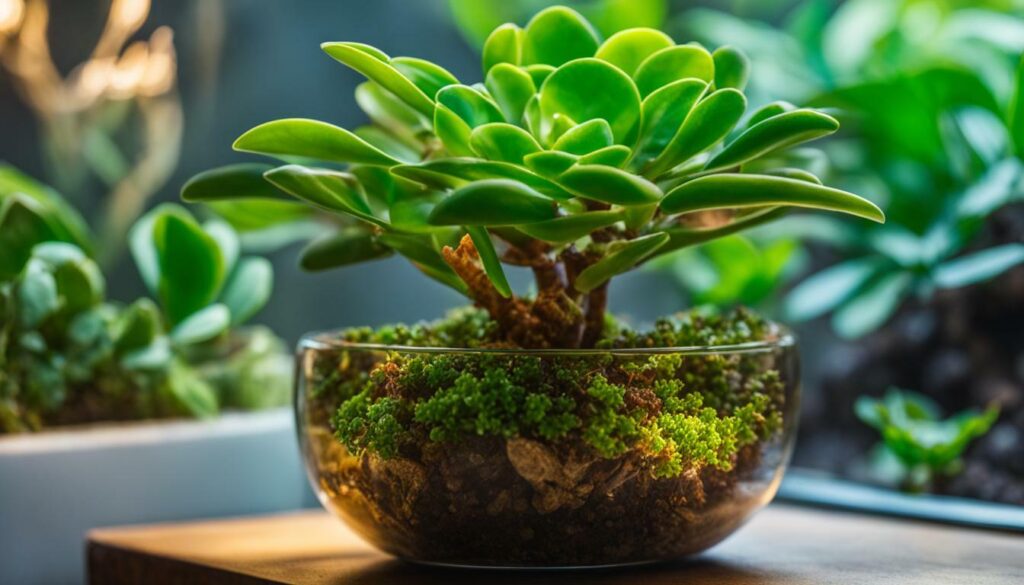
Discover unique terrarium ideas that incorporate jade plants to create a stunning display of indoor gardening. Terrariums are miniature ecosystems that can bring a touch of nature into any living space. They are perfect for those who want to add a splash of greenery to their home but have limited space or time for traditional gardening. By combining different plants and decorative elements, you can create a personalized terrarium that suits your style and preferences.
One popular terrarium design is the open glass container filled with layers of rocks, activated charcoal, and potting soil. This design allows for proper drainage and aeration, which is essential for the health of jade plants. You can arrange the jade plants at different heights and add moss, pebbles, or miniature figurines to create a whimsical scene. Another idea is to use a hanging glass terrarium, which can be suspended from the ceiling or wall, adding a unique touch to your indoor space.
If you prefer a more minimalist look, you can opt for a closed terrarium. This design uses a sealed glass container, creating a self-sustaining ecosystem. The humidity inside the terrarium allows jade plants to thrive without frequent watering. It’s important to choose plants that have similar water and light requirements to ensure they can coexist harmoniously. You can enhance the visual appeal of your closed terrarium by adding decorative elements such as driftwood, colorful stones, or small ornaments.
Table 1: Popular Terrarium Ideas
| Terrarium Idea | Description |
|---|---|
| Fairy Garden Terrarium | Create a whimsical garden scene with miniature fairy figurines, tiny houses, and colorful plants. |
| Desert Oasis Terrarium | Combine cacti, succulents, and sand to mimic a desert landscape. Add small rocks and driftwood for a natural touch. |
| Forest Wonderland Terrarium | Use moss, ferns, and small leafy plants to recreate a lush forest environment. Add miniature animals or fairies for a magical touch. |
Remember to choose a terrarium container that suits the size and style of your space. Glass containers are popular choices as they allow for easy viewing of the plants and create a beautiful display. Additionally, consider the lighting conditions in your home and select terrarium plants, such as jade plants, that can thrive in the available light.
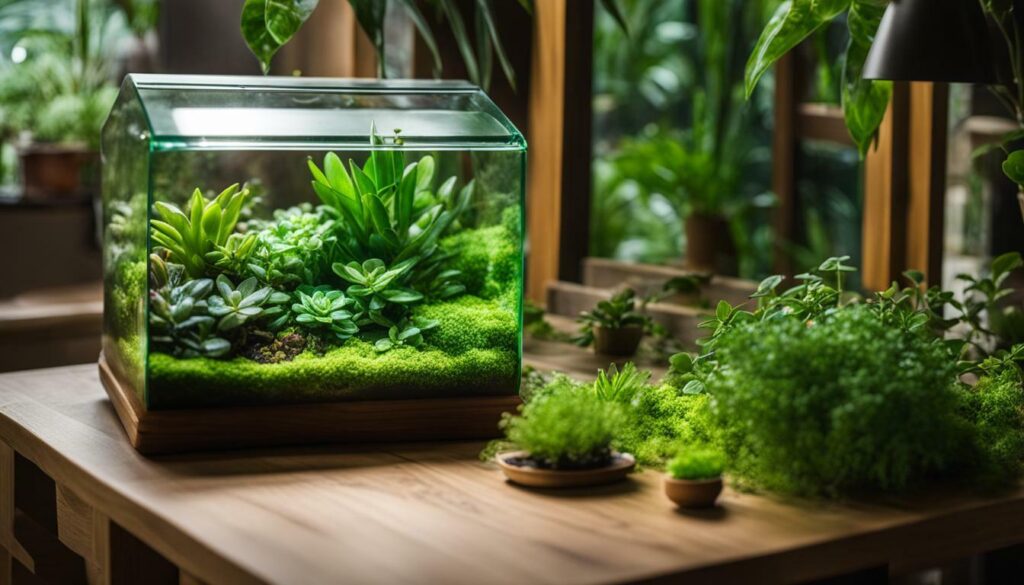
Incorporating jade plants into your terrarium not only adds a touch of elegance but also offers numerous benefits. Jade plants are known for their resilience and ability to survive in various conditions, making them excellent choices for terrariums. Their thick, fleshy leaves store water, allowing them to withstand periods of drought. This feature makes them perfect for low-maintenance terrariums.
Get creative with your terrarium ideas and let your imagination run wild. Experiment with different plant combinations, containers, and decorative elements to create a unique and eye-catching display. With the right care and attention, your jade plant terrarium can be a beautiful addition to your indoor space.
Essential Care Tips for Jade Plants in Terrariums
Proper care is crucial for jade plants in terrariums to ensure their health and longevity. These beautiful succulent houseplants require specific attention to thrive in a terrarium setting. Here are some essential care tips to keep your jade plants flourishing:
- Watering: Jade plants in terrariums should be watered sparingly. Overwatering can lead to root rot, while underwatering can cause the leaves to shrivel. Allow the top inch of soil to dry out between waterings. Use your finger to check the moisture level in the soil before watering again.
- Light Requirements: Jade plants need bright, indirect light to thrive. Place your terrarium in a location that receives at least 6 hours of sunlight each day. If natural light is limited, you can supplement with artificial grow lights.
- Temperature Conditions: Jade plants prefer room temperature, but they can tolerate cooler temperatures at night and during the winter. Keep your terrarium away from drafts and ensure a consistent temperature between 65°F – 75°F (18°C – 24°C).
- Fertilizing: Fertilize your jade plants sparingly using a diluted houseplant or cacti/succulent fertilizer. Apply the fertilizer during the spring and summer months, following the package instructions for dilution ratios. Overfertilizing can lead to burned roots, so it’s crucial to use caution.
- Repotting: Jade plants in terrariums generally don’t require frequent repotting. Young jade plants can be repotted every 2-3 years, while older plants can be repotted every 4-5 years. Use a well-draining potting mix and ensure the new pot is only slightly larger than the previous one.
- Pest Control: Jade plants are susceptible to pests like mealybugs and scale. Inspect your terrarium regularly and take immediate action if you spot any signs of infestation. Treat the affected areas with an appropriate insecticide or try natural pest control methods like neem oil.
Following these care tips will help ensure that your jade plants thrive and bring beauty to your terrarium. Remember to observe your plants closely and make adjustments as needed to provide the ideal conditions for their growth.
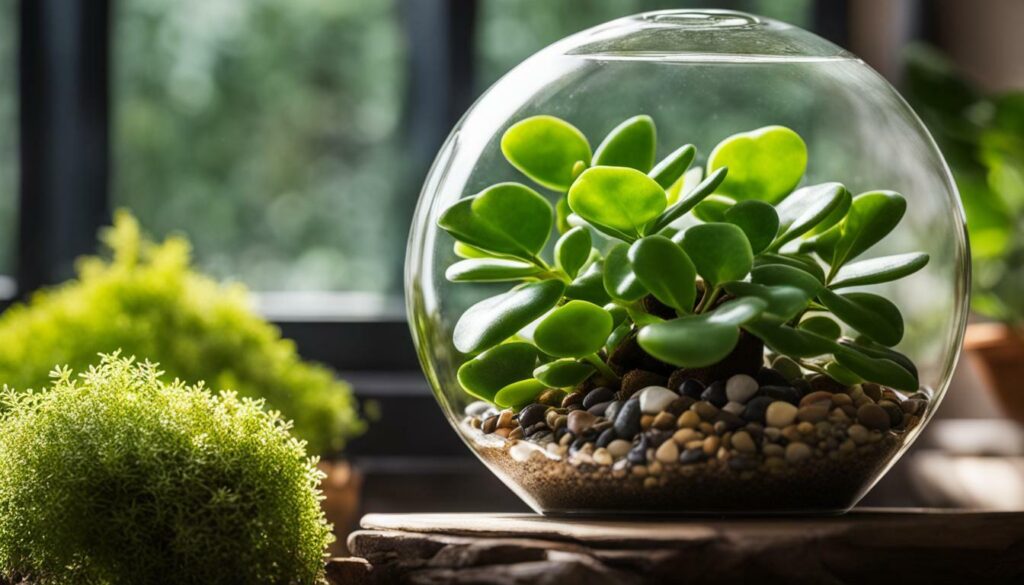
| Care Aspect | Guidelines |
|---|---|
| Watering | Allow the top inch of soil to dry out between waterings |
| Light Requirements | Provide at least 6 hours of bright, indirect light daily |
| Temperature | Maintain a consistent temperature between 65°F – 75°F (18°C – 24°C) |
| Fertilizing | Use a diluted houseplant or cacti/succulent fertilizer sparingly |
| Repotting | Repot every 2-3 years for young plants, every 4-5 years for older plants |
| Pest Control | Inspect regularly and treat any signs of pests with suitable methods |
Watering and Moisture Control for Jade Plants
Understanding the watering needs of jade plants in terrariums is essential to prevent issues like root rot or dehydration. Jade plants are succulents, which means they store water in their leaves and stems to survive dry conditions. While they are drought-tolerant, it’s important to provide them with adequate moisture without overwatering.
When it comes to watering jade plants in terrariums, it’s best to follow the “soak and dry” method. This means thoroughly watering the plant until water drains out of the bottom of the pot, and then allowing the soil to dry out completely before watering again. Overwatering can lead to root rot, which is one of the most common issues for jade plants in terrariums.
Tip: To determine when your jade plant needs water, stick your finger about an inch into the soil. If it feels dry at that depth, it’s time to water. Remember, it’s better to underwater than to overwater.
Another important aspect of moisture control for jade plants is the choice of potting mix. A well-draining mix is crucial to prevent excess moisture from sitting around the roots. You can create a suitable mix by combining equal parts of regular potting soil, perlite, and coarse sand. This will ensure good drainage while still retaining enough moisture for the plant.
| Watering guidelines for jade plants in terrariums: |
|---|
| – Water thoroughly until water drains out of the pot. |
| – Allow the soil to dry out completely before watering again. |
| – Stick your finger into the soil to determine when it needs water. |
| – Use a well-draining potting mix to prevent root rot. |
By following these guidelines and paying close attention to the watering needs of your jade plant, you can ensure it thrives in its terrarium environment. Remember, each plant may have slightly different needs, so it’s important to monitor their condition and adjust your watering routine accordingly.
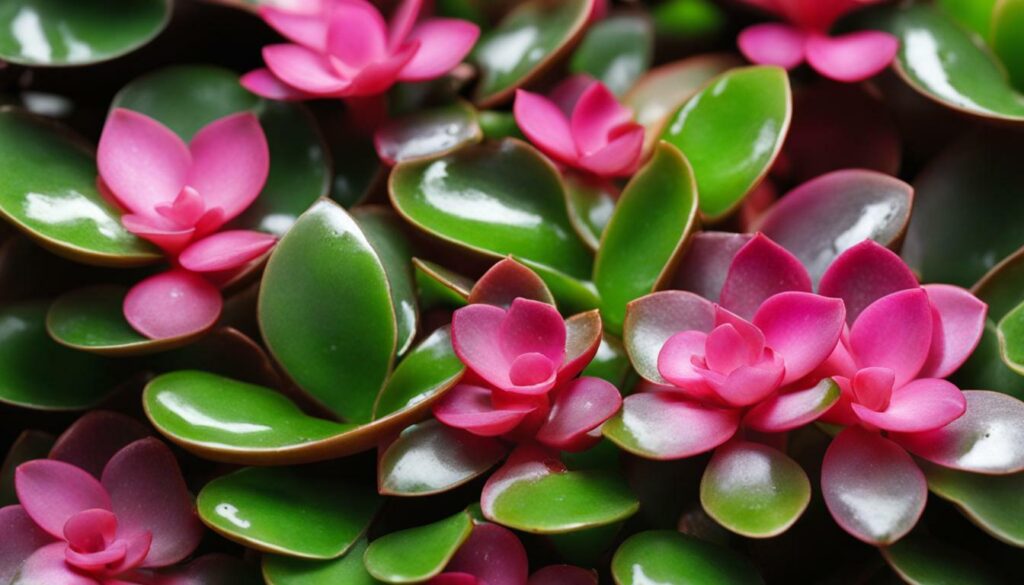
- Understand the “soak and dry” method – water thoroughly, then allow the soil to dry out completely between waterings.
- Stick your finger into the soil to determine when your jade plant needs watering.
- Use a well-draining potting mix to prevent root rot.
Light Requirements for Indoor Jade Plants
Jade plants thrive in bright, indirect light, making them ideal for indoor environments like terrariums. These beautiful succulents require at least 6 hours of sunlight each day to maintain their vibrant green color and compact growth. Placing your jade plant near a sunny window or using artificial grow lights will ensure it receives the necessary light for optimal growth.
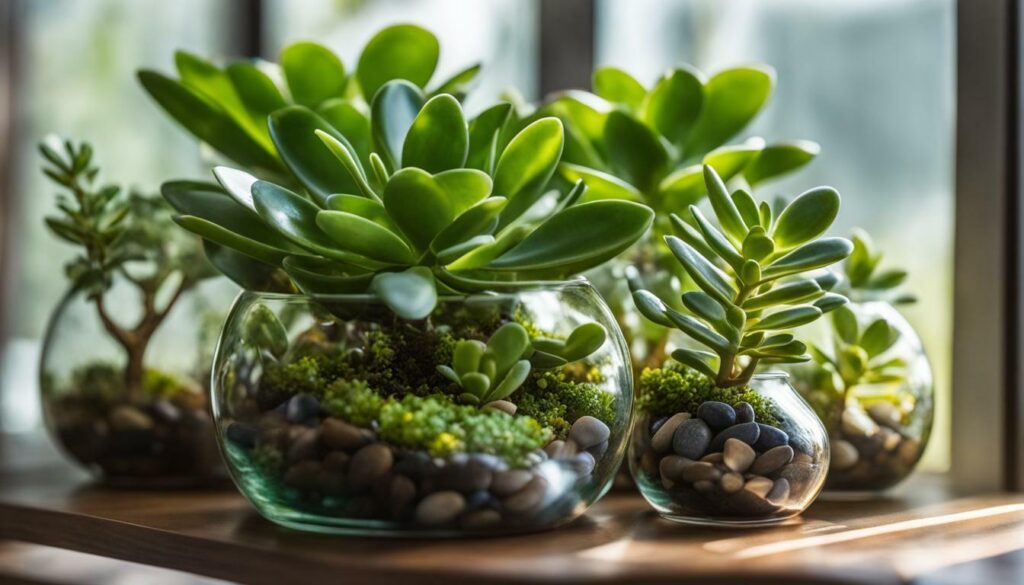
If you’re using a terrarium to house your jade plant, it’s important to position it in a location where it can receive adequate light. The glass walls of the terrarium can filter and reduce the intensity of sunlight, so be sure to choose a terrarium that allows enough light to reach your jade plant. Additionally, rotating the terrarium periodically will help ensure that all sides of your plant receive even light exposure.
Keep in mind that although jade plants thrive in bright light, they can be sensitive to direct sunlight, especially during the hot summer months. Direct sunlight can cause sunburn and damage the leaves of your jade plant. To protect your plant, provide it with filtered or indirect sunlight, or use sheer curtains to diffuse the light.
In summary, jade plants require bright, indirect light to thrive indoors. Whether you choose to place them near a sunny window or use artificial grow lights, ensuring they receive at least 6 hours of sunlight each day will promote healthy growth and vibrant foliage. Just remember to protect them from direct sunlight to prevent any damage. With the right amount of light, your jade plant will flourish in your terrarium and add a touch of natural beauty to your indoor space.
Maintaining Temperature Conditions for Jade Plants in Terrariums
Proper temperature regulation is vital to ensure the well-being of jade plants within terrariums. These succulent beauties thrive in warm indoor environments, ideally between 65°F to 75°F (18°C to 24°C). Although they can tolerate slightly cooler temperatures, it’s important to avoid exposing them to drafts or sudden temperature fluctuations, as this can stress the plants.
During the nighttime, it’s recommended to provide jade plants with a slightly cooler temperature, around 55°F to 60°F (13°C to 15°C), to mimic their natural habitat. This drop in temperature helps simulate the conditions they would experience in their native regions, promoting healthy growth and development.
When positioning your terrarium, make sure it is placed away from heating or cooling vents, windows, and doors. These areas can expose the plants to extreme temperatures or drafts that can be detrimental to their well-being. Consistency is key when it comes to temperature, so maintaining a stable environment is essential for thriving jade plants.
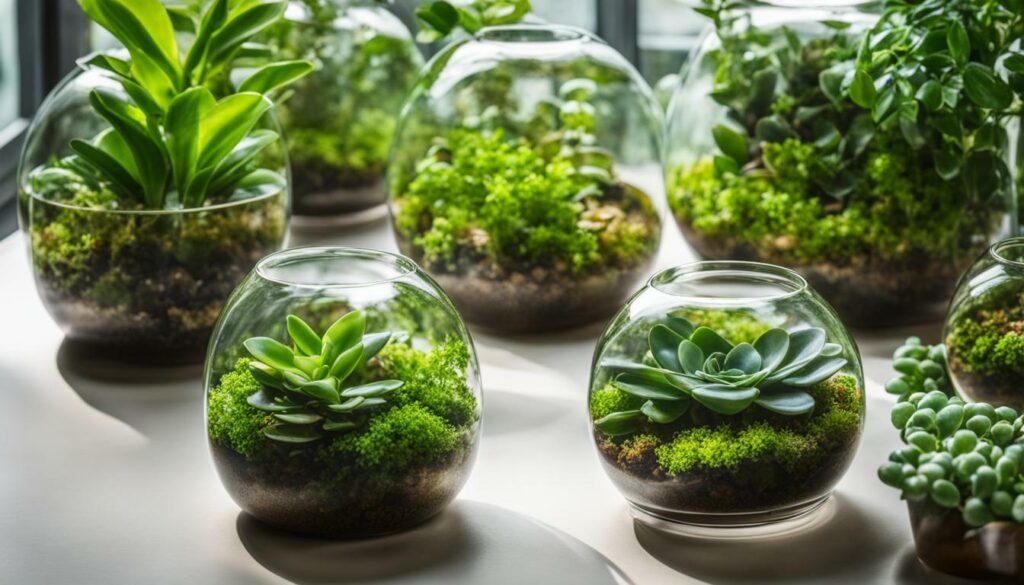
| Time of Day | Ideal Temperature Range (°F) |
|---|---|
| Daytime | 65°F to 75°F |
| Nighttime | 55°F to 60°F |
By maintaining suitable temperature conditions, you can create an optimal environment for your jade plants to thrive. Remember to monitor the temperature regularly and make any necessary adjustments to ensure the well-being of your terrarium plants. With proper care and attention, your jade plants will continue to bring beauty and serenity to your indoor garden.
Fertilizing and Repotting Jade Plants
Discover when and how to fertilize and repot your jade plants to promote their growth and vitality. Fertilizing jade plants is essential for providing them with the necessary nutrients to thrive. These plants have low nutrient requirements and can be fertilized sparingly. A diluted houseplant or cacti/succulent fertilizer can be applied once every three to four months during the growing season, from spring to fall. Before applying fertilizer, make sure the soil is damp to prevent root burn.
Repotting jade plants should be done every 2-3 years for young plants and every 4-5 years for older ones. Repotting provides them with fresh soil and more space for their roots to grow. Choose a well-draining potting mix and a slightly larger pot to accommodate the plant’s size. Gently remove the plant from its current pot, taking care not to damage the delicate roots. Remove any dead or rotten roots and replant the jade plant in the new pot, adding fresh soil around the roots. Water the plant thoroughly after repotting to help it settle into its new environment.
Fertilizing and repotting are important aspects of jade plant care that help maintain their health and encourage optimal growth. By following these guidelines, you can ensure that your jade plants thrive and remain vibrant in your terrarium.
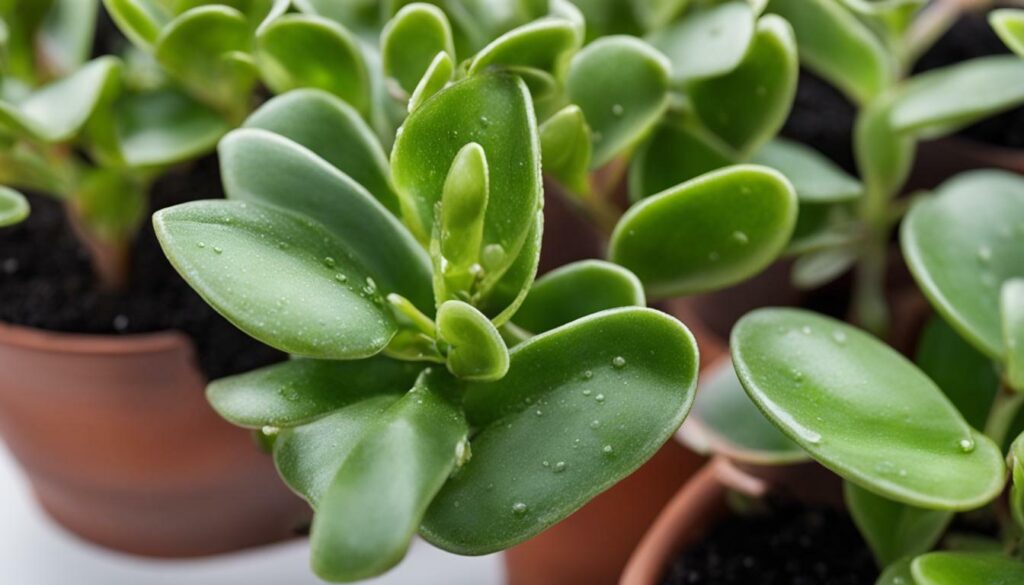
| Fertilizing Jade Plants | Repotting Jade Plants |
|---|---|
|
|
Dealing with Pests and Potential Issues
Learn how to identify and tackle pests and issues that may affect the health of your jade plants in a terrarium. While jade plants are generally resilient, they can still face challenges from common pests and diseases. Mealybugs and scale are two common pests that can infest jade plants, causing damage to the leaves and stems. To combat these pests, remove them manually with a cotton swab dipped in rubbing alcohol, or use natural insecticidal soap to treat the affected areas. Regularly inspect your plants for signs of infestation, and take action at the first sight of pests to prevent further damage.
Jade plants are also prone to root rot if overwatered. To avoid this issue, it is essential to provide proper drainage and allow the soil to dry out between waterings. When watering your jade plant, ensure that excess water can freely flow out of the pot. If you notice signs of root rot, such as yellowing or wilting leaves, remove the affected parts and repot the plant in fresh, well-draining soil.
Another potential issue to be mindful of is fungal diseases. Excessive moisture and poor air circulation can create a favorable environment for fungal growth. Prevent fungal infections by avoiding overwatering and providing adequate ventilation. If you notice signs of fungal disease, such as black spots or powdery residue on the leaves, treat the plant with a fungicide following the manufacturer’s instructions.
To summarize, the key to maintaining healthy jade plants in a terrarium is vigilance. Regularly inspect your plants for signs of pests or diseases, and take immediate action if any issues arise. By providing proper care, including adequate lighting, well-draining soil, and appropriate watering, you can ensure the longevity and vitality of your jade plants in a terrarium.
| Pest/Disease | Identification | Treatment |
|---|---|---|
| Mealybugs | Small white cotton-like insects typically found along leaf joints and undersides. | Remove manually with alcohol-soaked cotton swab or use insecticidal soap. |
| Scale | Tiny, oval-shaped insects that adhere to stems and leaves, often covered in a waxy shell. | Remove manually with alcohol-soaked cotton swab or use insecticidal soap. |
| Root Rot | Yellowing or wilting leaves, mushy roots, foul odor. | Remove affected parts, repot in fresh, well-draining soil. |
| Fungal Diseases | Black spots, powdery residue on leaves. | Treat with fungicide following manufacturer’s instructions. |
Quote:
“Prevention is key when it comes to pests and diseases in terrariums. Inspect your plants regularly and address any issues promptly to ensure the health and beauty of your jade plants.” – Gardening Expert
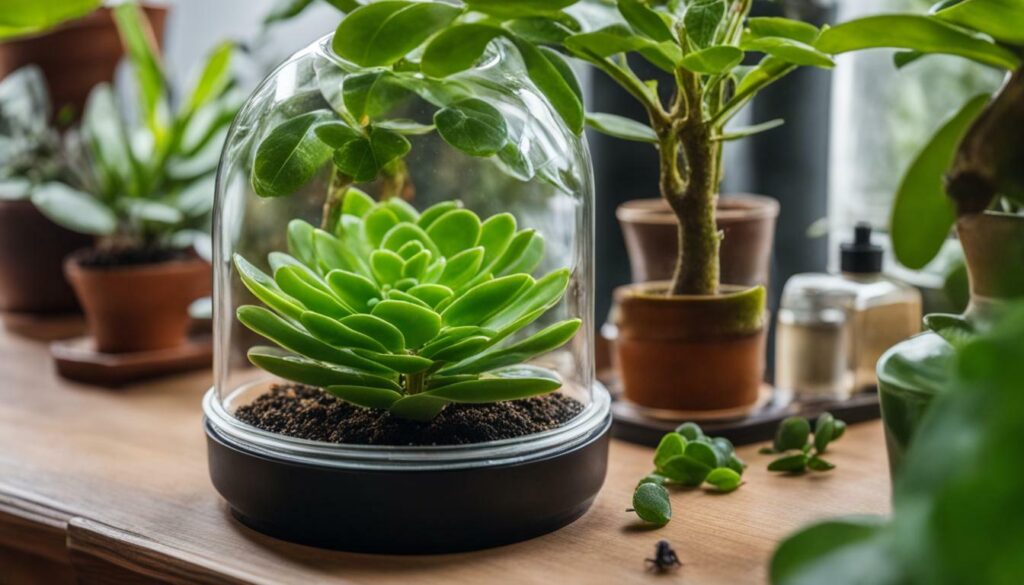
- Inspect your jade plants regularly for signs of pests and diseases, such as mealybugs, scale, root rot, and fungal infections.
- Take immediate action at the first sign of pests, using manual removal or natural insecticidal soap.
- Provide proper drainage and avoid overwatering to prevent root rot.
- Ensure good air circulation and avoid excessive moisture to prevent fungal diseases.
Outdoor Considerations for Jade Plants in Terrariums
Discover whether it’s appropriate to showcase your jade plants in outdoor terrariums. Jade plants are popular succulent houseplants that can thrive in a variety of environments. While they are typically grown indoors, jade plants can also adapt to outdoor settings, particularly in mild, dry climates. However, there are a few important factors to consider before exposing your jade plants to the elements.
Jade plants have thick, woody stems and oval-shaped leaves, making them well-suited for outdoor terrariums. When placed outside, they can reach heights of three feet or more, creating a striking focal point in your garden or patio. Their ability to withstand warm and dry conditions makes them an ideal choice for outdoor environments.
It’s important to note, however, that jade plants are susceptible to cold damage. They cannot tolerate freezing temperatures, so if you live in an area with harsh winters, it’s best to keep your jade plants indoors during the colder months. Frost can cause significant damage to the leaves and stems, leading to irreversible harm to the plant.
| Pros of Outdoor Terrariums with Jade Plants | Cons of Outdoor Terrariums with Jade Plants |
|---|---|
|
|
Despite these considerations, many jade plant enthusiasts find success in growing their plants outdoors. By carefully monitoring the weather and providing adequate protection during colder months, you can showcase your jade plants in beautiful outdoor terrariums.
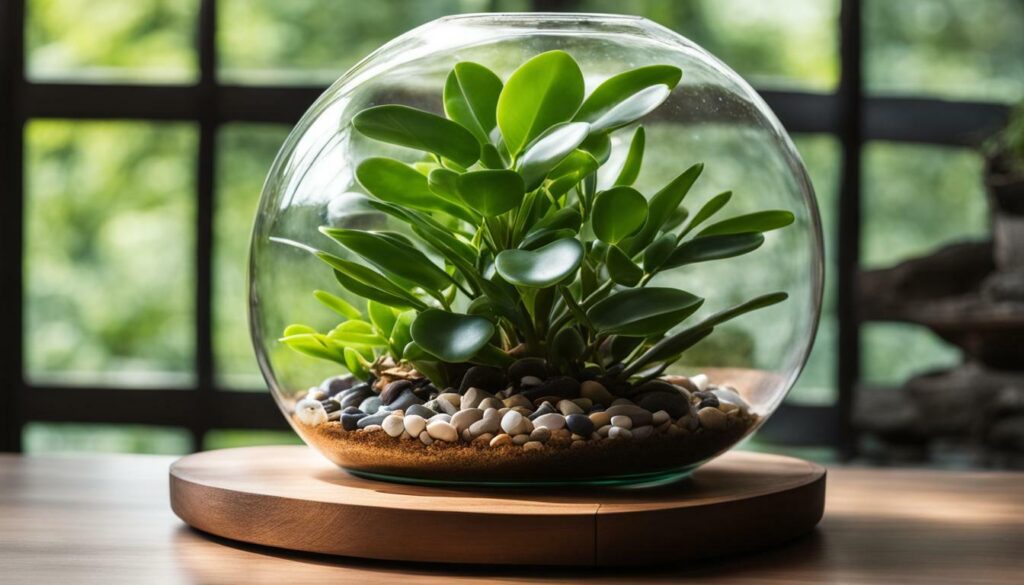
By following proper care guidelines, jade plants can thrive in terrariums and bring beauty to indoor gardening spaces. These popular succulent houseplants are known for their thick, woody stems and oval-shaped leaves. When grown indoors, they can reach impressive heights of three feet or more.
Jade plants are well-suited for most homes’ warm, dry conditions but require regular watering during the growing season. It’s important to allow the soil to dry out between waterings to prevent rot. In mild, dry climates, jade plants can also be grown outdoors, but they are susceptible to cold damage.
Propagating jade plants is relatively easy and can be done by using leaf or stem cuttings. Before planting, the cuttings should be allowed to form callouses and then placed in a well-draining potting mix.
Proper lighting is essential for jade plants to thrive. They prefer bright, indirect light and should receive at least six hours of sunlight each day. While they thrive in room temperature, they can tolerate cooler temperatures at night and in the winter.
When it comes to fertilizing, jade plants require sparing use of a diluted houseplant or cacti/succulent fertilizer. Repotting is only necessary every 2-3 years for young jade plants and every 4-5 years for older plants.
It’s important to note that jade plants are toxic to pets and can be vulnerable to pests like mealybugs and scale. Regular monitoring and treatment can help keep these issues at bay.
Overall, jade plants are easy to care for and make beautiful additions to terrariums. Their resilience and striking appearance make them a great choice for indoor gardening enthusiasts.
Can Peperomia Plants and Jade Plants Thrive Together in the Same Terrarium?
Peperomia plants care tips are essential when considering their compatibility with jade plants in the same terrarium. Both plants have different humidity and watering needs. While jade plants prefer drier soil, peperomia plants require regular watering. It is best to keep them in separate containers to ensure proper care and growth.
FAQ
Can jade plants be grown outdoors?
Jade plants can be grown outdoors in mild, dry climates. However, they are susceptible to cold damage and should be protected during colder months.
How often should I water my jade plant?
During the growing season, jade plants should be watered thoroughly and allowed to dry out between waterings. It’s important to avoid overwatering, as this can lead to root rot.
How often should I fertilize my jade plant?
Jade plants should be fertilized sparingly using a diluted houseplant or cacti/succulent fertilizer. It’s best to fertilize during the growing season, typically every 2-4 weeks.
How often should I repot my jade plant?
Young jade plants may need to be repotted every 2-3 years, while older plants can be repotted every 4-5 years. It’s important to use a well-draining potting mix when repotting.
Are jade plants toxic to pets?
Yes, jade plants are toxic to pets. It’s important to keep them out of reach of curious animals to prevent ingestion.
What pests are common for jade plants?
Jade plants can be susceptible to pests such as mealybugs and scale. Regularly inspect your plant for signs of infestation and treat accordingly.

